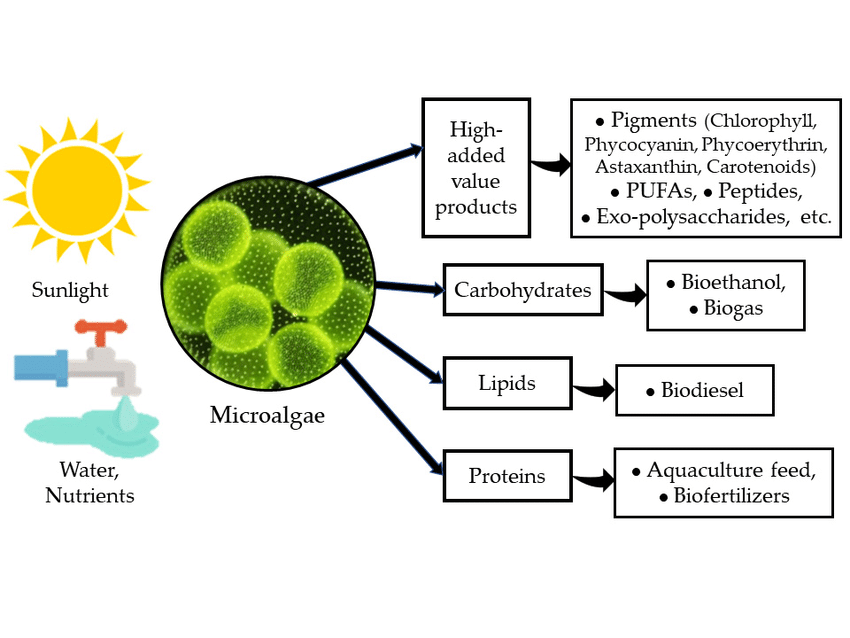Chlorella Growth Factor | 15 Jun 2024
Why in News?
Recently, scientists at CSIR-Indian Institute of Chemical Technology (IICT) have spotlighted the potential of Chlorella Growth Factor (CGF), a protein-rich extract derived from the microalgae ‘Chlorella sorokiniana’, as an ideal ingredient for a wide range of food and feed applications.
What are Chlorella Growth Factor (CGF) and Chlorella Sorokiniana?
- Chlorella Growth Factor (CGF):
- Nutritional Benefits: CGF is rich in amino acids and proteins of high quality, making it a promising alternative source for both human and animal diets.
- Production Method: The extraction of CGF involves a non-chemical autolysis process, preserving the integrity of amino acids and other valuable components.
- Application: Adding CGF to chicken feed improves egg quality, showing promise as a better protein supplement for animals.
- Sustainability: Microalgae like Chlorella sorokiniana are considered "under-exploited crops" that do not compete with traditional food crops for space and resources, offering a sustainable solution to meet the increasing global demand for high-quality protein sources.
- Chlorella Sorokiniana:
- Chlorella Sorokiniana, an oval-shaped single-celled algae, is a standout in the microscopic realm, boasting a unique ability to grow actively.
- Each cell is a self-contained organism with all the essential nutrients needed for life, making it complete and self-sustaining.
- Chlorella Sorokiniana can rapidly reproduce, growing from one cell to 24 cells in just 24 hours when exposed to plenty of sunlight and nutrients.
- Chlorella Sorokiniana, an oval-shaped single-celled algae, is a standout in the microscopic realm, boasting a unique ability to grow actively.
Microalgae
- Microalgae are photosynthetic microorganisms that can be found in diverse natural environments, such as water, rocks, and soil. They present higher photosynthetic efficiency than terrestrial plants and are responsible for a significant fraction of the world's oxygen production.
- They thrive in various aquatic environments, including both freshwater and marine habitats. For example Chlorella, Diatoms, etc.
- Marine microalgae play a pivotal role in the oceanic food chain and carbon dioxide absorption.
- However, as climate change continues, global warming is causing surface ocean waters to warm, resulting in reduced nutrient availability due to less mixing between the surface waters and nutrient-rich deeper waters.
Macroalgae
- Macroalgae popularly known as seaweeds are multicellular and macroscopic autotrophs that are taxonomically categorised into three distinct groups based on the colour of the thallus namely Chlorophyta (green algae), Rhodophyta (red algae), and phaeophyta (brown algae).
- Seaweed is the primitive, non-flowering marine algae without roots, stems and leaves, that play a major role in marine ecosystems.
- Large seaweeds form dense underwater forests known as kelp forests, which act as underwater nurseries for fish, snails and sea urchins.
- Some species of seaweeds include Gelidiella acerosa, Gracilaria edulis, Gracilaria crassa, and Gracilaria verrucosa.
- Seaweed is the primitive, non-flowering marine algae without roots, stems and leaves, that play a major role in marine ecosystems.
UPSC Civil Services Examination, Previous Year Question (PYQ)
Prelims:
Q. Consider the following statements in respect of probiotics: (2022)
- Probiotics are made of both bacteria and yeast.
- The organisms in probiotics are found in foods we ingest but they do not naturally occur in our gut.
- Probiotics help in the digestion of milk sugars.
Which of the statements given above is/are correct?
(a) 1 only
(b) 2 only
(c) 1 and 3
(d) 2 and 3
Ans: (c)
Mains
Q. What are the research and developmental achievements in applied biotechnology? How will these achievements help to uplift the poorer sections of the society? (2021)
Q. How can biotechnology help to improve the living standards of farmers? (2019)

